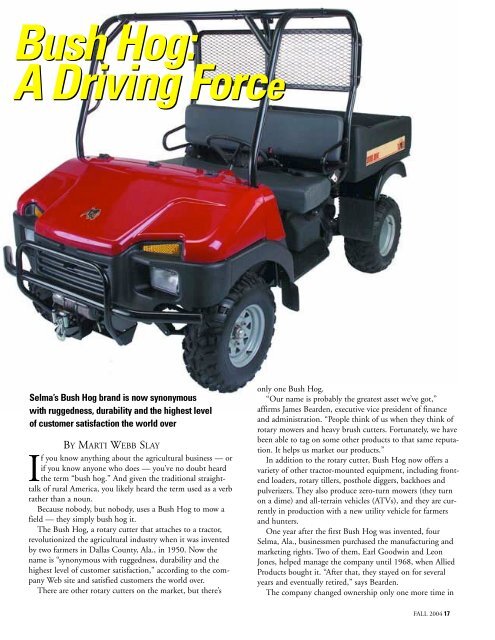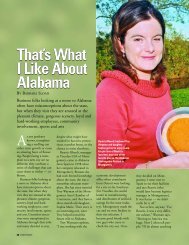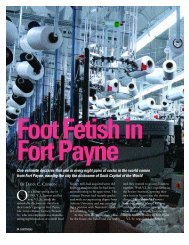Bush Hog - Economic Development Partnership of Alabama
Bush Hog - Economic Development Partnership of Alabama
Bush Hog - Economic Development Partnership of Alabama
Create successful ePaper yourself
Turn your PDF publications into a flip-book with our unique Google optimized e-Paper software.
<strong>Bush</strong> <strong>Hog</strong>:A Driving ForceS e l m a ’s <strong>Bush</strong> <strong>Hog</strong> brand is now synonymouswith ruggedness, durability and the highest level<strong>of</strong> customer satisfaction the world overBY MARTI WEBB SLAYIf you know anything about the agricultural business — orif you know anyone who does — you’ve no doubt heardthe term “bush hog.” And given the traditional straighttalk<strong>of</strong> rural America, you likely heard the term used as a verbrather than a noun.Because nobody, but nobody, uses a <strong>Bush</strong> <strong>Hog</strong> to mow afield — they simply bush hog it.The <strong>Bush</strong> <strong>Hog</strong>, a rotary cutter that attaches to a tractor,revolutionized the agricultural industry when it was inventedby two farmers in Dallas County, Ala., in 1950. Now thename is “synonymous with ruggedness, durability and thehighest level <strong>of</strong> customer satisfaction,” according to the companyWeb site and satisfied customers the world over.There are other rotary cutters on the market, but there’sonly one <strong>Bush</strong> <strong>Hog</strong>.“Our name is probably the greatest asset we’ve got,”affirms James Bearden, executive vice president <strong>of</strong> financeand administration. “People think <strong>of</strong> us when they think <strong>of</strong>rotary mowers and heavy brush cutters. Fortunately, we havebeen able to tag on some other products to that same reputation.It helps us market our products.”In addition to the rotary cutter, <strong>Bush</strong> <strong>Hog</strong> now <strong>of</strong>fers avariety <strong>of</strong> other tractor-mounted equipment, including frontendloaders, rotary tillers, posthole diggers, backhoes andpulverizers. They also produce zero-turn mowers (they turnon a dime) and all-terrain vehicles (ATVs), and they are currentlyin production with a new utility vehicle for farmersand hunters.One year after the first <strong>Bush</strong> <strong>Hog</strong> was invented, fourSelma, Ala., businessmen purchased the manufacturing andmarketing rights. Two <strong>of</strong> them, Earl Goodwin and LeonJones, helped manage the company until 1968, when AlliedProducts bought it. “After that, they stayed on for severalyears and eventually retired,” says Bearden.The company changed ownership only one more time inFALL 2004 17
<strong>Bush</strong> <strong>Hog</strong>: A Driving Forceits 50-year history, when Crown CompanyIndustries bought it in March2000.<strong>Bush</strong> <strong>Hog</strong> currently employs 950people in Selma, in two different locations.The downtown plant, where thecompany started, has expanded to thelimit, and a second plant about fivemiles outside town houses theResearch and <strong>Development</strong> Centerwhere the majority <strong>of</strong> engineeringwork, including design and prototypetesting, is done.Athird plant in Tennesseeemploys about 300 people.“We had a plant in Kansas,but we needed to consolidate,” saysBearden, “so we built in Tennessee.We wanted to stay at 850-900 here in<strong>Alabama</strong>. It stretches our facilities andour ability to manage that many peoplein one location.” The Tennesseeplant produces front-end loaders. Thezero-turn mowers will also be producedthere. The <strong>Alabama</strong> plantsmanufacture all the rotary cutters, finishingmowers, posthole diggers andlandscape products.All products are delivered to dealersaround the country using the fleet <strong>of</strong>65 over-the-road trucks and 250 trailersdriven by <strong>Bush</strong> <strong>Hog</strong> employees.The company fleet also transportsmost materials for factory use.A strong dealer network around thecountry is a key factor in <strong>Bush</strong> <strong>Hog</strong>’ssuccess. “We seek to be represented bythe most progressive dealer in eachgeographical trade area,” the companyWeb site says.“Our dealers are typically farmWhat’s in a Name?When the <strong>Bush</strong> <strong>Hog</strong> rotary cutter was designed in 1950, it revolutionizedthe agricultural industry. Prior to that time, farmers cleared land using a sicklebar mower. “The closest way I can explain one is to look at a pair <strong>of</strong> hedgetrimmers,” explains James Bearden, executive vice president <strong>of</strong>finance and administration for <strong>Bush</strong> <strong>Hog</strong> LLC. “People usedsomething similar to that to cut grass, but if you are trying tocut a four-inch tree, that’s just not going to do it.” Users hadto manually cut larger brush, a hard, time-consuming effort.Then the <strong>Bush</strong> <strong>Hog</strong> rotary cutter was introduced. The tractorruns over the tree, and the <strong>Bush</strong> <strong>Hog</strong> cuts it.In the early years, the machines were largely sold by fielddemonstrations. According to legend, one farmer who was watching a demonstrationcommented, “That machine goes through bushes like a hog.”The name <strong>Bush</strong> <strong>Hog</strong> was born, and today it is the industry standard for arotary cutter that clears brush and debris like no other.18 PARTNERSJames Bearden, executive vice president <strong>of</strong> finance and administration (above), says <strong>Bush</strong><strong>Hog</strong> currently employs 950 people in Selma, in two different locations. The <strong>Alabama</strong> plantsmanufacture all the rotary cutters, finishing mowers, posthole diggers and landscape products(opposite page).equipment dealers who sell the JohnDeere tractor line or Kubota or otherbig names. They’ll have a main tractorline, and they’ll have a <strong>Bush</strong> <strong>Hog</strong> lineto sell as attachments to their tractors,”Bearden explains. “We havedealers all over, from east coast to westcoast, from Texas to Canada.”Like their customers, their dealersare loyal. Dave Lock, owner <strong>of</strong> ZimmerschiedFarm Equipment in Carrollton,Mo., says his company hashandled the <strong>Bush</strong> <strong>Hog</strong> line for 37years, and he has no plans to changenow. “Our original owner hooked upwith <strong>Bush</strong> <strong>Hog</strong> and he was very happywith their quality and service. I tookover later, and I’ve carried on the sametradition. <strong>Bush</strong> <strong>Hog</strong> has becomeknown as the Cadillac <strong>of</strong> brush cuttersaround this part <strong>of</strong> the country. I’vehad real good luck with their service,and their warranty work is outstanding.We’ve always been happy withthem.”In addition to the tractor attachments,<strong>Bush</strong> <strong>Hog</strong> is now entering theutility vehicle market, amid glowingreviews. The Trail Hand, “for farmers,ranchers and country folks,” can be
used to tote rectangular hay bales orhaul feed into the field. With a payloadcapacity <strong>of</strong> 1,500 pounds, thevehicle can also tow the same amount.The Trail Hunter provides a smoothride for hunters entering rough,remote areas looking for game. <strong>Bush</strong><strong>Hog</strong>’s new <strong>of</strong>f-road Trail Series utilityvehicles “live up to the company’sreputation for performance youcan count on in rugged conditions,while delivering a more comfortableride,” accordingto the companyWeb site. Theutility vehiclesare being manufacturedin the<strong>Alabama</strong> plants.“Our prices are competitive and wehave some features that make ours amuch better unit,” Bearden says.“We’ve got a better suspension anddrive system that we’re very proud <strong>of</strong>.”While the company does prideitself on being innovative, it alsoremembers its roots. “We’ve expandedthat basic rotary cutter line that wasoriginally designed to clear heavybrush and debris,” says Bearden.“We’ve developed that into a completeline <strong>of</strong> rotary cutters. We sell cutters42 inches wide up to 20 feet wide,and with a vast assortment <strong>of</strong> models…anythingthat can do very roughcutting to a finishing mower that givesalmost a lawn mower type finish.”They’ve also stayed true to the citythat gave birth to the <strong>Bush</strong> <strong>Hog</strong>.“Throughout the last 50years, the management <strong>of</strong>the company hasstayed in Selma,”Bearden says. “Wehave ownedplaces all overthe country,but we’vealways managedthem from the coreplant here in Selma.“That primarily isattributable to the work force here,”he continues. “We have developed along-term management team that’sbeen in place for a long time. Thepresident [Bobby Middlebrooks] hasbeen with the company approaching50 years. We have a good, core group<strong>of</strong> people who know a lot about theagricultural business and know a lotabout <strong>Bush</strong> <strong>Hog</strong>. I can’t say enoughabout the work force here [in<strong>Alabama</strong>]. Throughout our two ownershipchanges, [company leaders] recognizedthe value <strong>of</strong> the work forceand haven’t made any efforts tochange locations.”Not everyone who works from thecompany is originally from Selma, oreven <strong>Alabama</strong>. “Like any big company,we recruit from all over,”explains Bearden. Have they had troublebringing people to Selma fromother parts <strong>of</strong> the country? Not particularly,he says. “If we can get themhere and keep them here for a littlewhile, they fall in love with Selma andstay here.” For those who don’t like asmall, rural community, they can livein Prattville or Montgomery. Thecommute is about an hour, a drivethat those from bigger cities are used to.Still, there are plenty <strong>of</strong> hometownfolks who have worked for<strong>Bush</strong> <strong>Hog</strong> for years, even generations.“That’s part <strong>of</strong> our <strong>Bush</strong> <strong>Hog</strong>legacy. We have people who stay herea long time,” says Bearden. “We havea lot <strong>of</strong> families, the father, son andgrandson or the husband and wifethat work together. We have a lot <strong>of</strong>that here, and we’re proud <strong>of</strong> that.”They are equally as proud <strong>of</strong> theircommunity and show that pride intheir commitment to it. “They aregood corporate citizens,” says WayneVardaman, president <strong>of</strong> the Center forCommerce in Selma. “They are ourlargest employer, but they mean moreto us than just the economic impact.They are good community leaders.They’re highly involved in the YMCA,Chamber <strong>of</strong> Commerce, <strong>Economic</strong><strong>Development</strong> Authority, United Wayand other special things.” And whenthe Chamber <strong>of</strong> Commerce and <strong>Economic</strong><strong>Development</strong> Authority cametogether to form the Center for Commerce,James Bearden was the firstpresident.Clearly, <strong>Bush</strong> <strong>Hog</strong> is not just synonymouswith brush cutting, but witha commitment to its employees andits community as well.■FALL 2004 19





